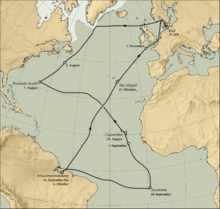Plankton Expedition
Launched in 1889, the Plankton Expedition was the first scientific effort to systematically study marine plankton—small, drifting aquatic organisms.
[1] Victor Hensen, a physiologist from the University of Kiel in Germany, first used the word “plankton” in 1887 to refer to those organisms in the ocean that drift with the currents, rather than moving around under their own power.
In addition to Hensen, the expedition consisted of a team of five scientists and an artist: zoologist Frederick Dahl, physiologist and protistologist Karl Brandt, botanist Franz Schütt, geographer Otto Krümmel, and microbiologist Bernard Fischer, as well as artist Richard Eschke.
[2] The crew steamed out on the National across major regions of the Atlantic (Figure 1) between July and November 1889, collecting plankton from over 100 stations down to a depth of 200m.
The expedition reports detailing the types of marine plankton collected [4] are the legacy of the endeavor and are credited with the eventual development of the field of microbiology.

